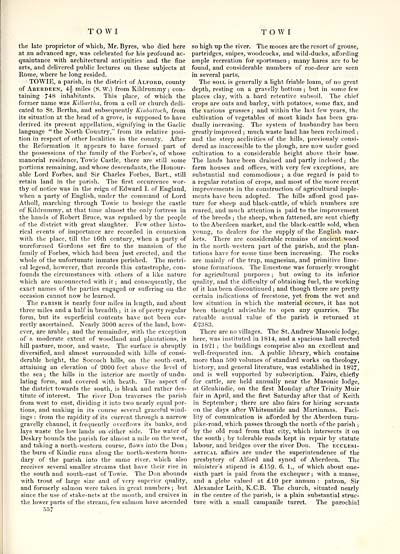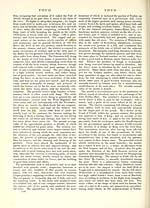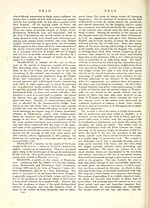Topographical dictionary of Scotland > Volume 2
(565) Page 557
Download files
Complete book:
Individual page:
Thumbnail gallery: Grid view | List view

T O WI
TO W I
the late proprietor of which, Mr. Byres, who died here
at an advanced age, was celebrated for his profound ac-
quaintance with architectural antiquities and the fine
arts, and delivered public lectures on these subjects at
Rome, where he long resided.
• TOWIE, a parish, in the district of Alford, county
of Aberdeen, 4| miles (S. W.) from Kildrummy; con-
taining 748 inhabitants. This place, of which the
former name was Kilbartha, from a cell or church dedi-
cated to St. Bertha, and subsequently Kinbattoch, from
its situation at the head of a grove, is supposed to have
derived its present appellation, signifying in the Gaelic
language " the North Country," from its relative posi-
tion in respect of other localities in the county. After
the Reformation it appears to have formed part of
the possessions of the family of the Forbes's, of whose
manorial residence, Towie Castle, there are still some
portions remaining, and whose descendants, the Honour-
able Lord Forbes, and Sir Charles Forbes, Bart., still
retain land in the parish. The first occurrence wor-
thy of notice was in the reign of Edward I. of England,
when a party of English, iinder the command of Lord
Atholl, marching through Towie to besiege the castle
of Kildrummy, at that time almost the only fortress in
the hands of Robert Bruce, was repulsed by the people
of the district with great slaughter. Few other histo-
rical events of importance are recorded in connexion
with the place, till the 16th century, when a party of
unreformed Gordons set fire to the mansion of the
family of Forbes, which had been just erected, and the
whole of the unfortunate inmates perished. The metri-
cal legend, however, that records this catastrophe, con-
founds the circumstances with others of a like nature
which are unconnected with it; and consequently, the
exact names of the parties engaged or suffering on the
occasion cannot now be learned.
The parish is nearly four miles in length, and about
three miles and a half in breadth ; it is of pretty regular
form, but its superficial contents have not been cor-
rectly ascertained. Nearly 3000 acres of the land, how-
ever, are arable ; and the remainder, with the exception
of a moderate extent of woodland and plantations, is
hill pasture, moor, and waste. The surface is abruptly
diversified, and almost surrounded with hills of consi-
derable height, the Soccoch hills, on the south-east,
attaining an elevation of 2000 feet above the level of
the sea ; the hills in the interior are mostly of undu-
lating form, and covered with heath. The aspect of
the district towards the south, is bleak and rather des-
titute of interest. The river Don traverses the parish
from west to east, dividing it into two nearly equal por-
tions, and making in its course several graceful wind-
ings : from the rapidity of its current through a narrow
gravelly channel, it frequently overflows its banks, and
lays waste the low lands on either side. The water of
Deskry bounds the parish for almost a mile on the west,
and taking a north-western course, flows into the Don;
the burn of Kindie runs along the north-western boun-
dary of the parish into the same river, which also
receives several smaller streams that have their rise in
the south and south-east of Towie. The Don abounds
with trout of large size and of very superior quality,
and formerly salmon were taken in great numbers ; but
since the use of stake-nets at the mouth, and cruives in
the lower parts of the stream, few salmon have ascended
557
so high up the river. The moors are the resort of grouse,
partridges, snipes, woodcocks, and wild-ducks, affording
ample recreation for sportsmen ; many hares are to be
found, and considerable numbers of roe-deer are seen
in several parts.
The soil is generally a light friable loam, of no great
depth, resting on a gravelly bottom ; but in some few
places clay, with a hard retentive subsoil. The chief
crops are oats and barley, with potatoes, some flax, and
the various grasses ; and within the last few years, the
cultivation of vegetables of most kinds has been gra-
dually increasing. The system of husbandry has been
greatly improved ; much waste land has been reclaimed ;
and the steep acclivities of the hills, previously consi-
dered as inaccessible to the plough, are now uuder good
cultivation to a considerable height above their base.
The lands have been drained and partly inclosed ; the
farm houses and offices, with very few exceptions, are
substantial and commodious ; a due regard is paid to
a regular rotation of crops, and most of the more recent
improvements in the construction of agricultural imple-
ments have been adopted. The hills afford good pas-
ture for sheep and black-cattle, of which numbers are
reared, and much attention is paid to the improvement
of the breeds ; the sheep, when fattened, are sent chiefly
to the Aberdeen market, and the black-cattle sold, when
young, to dealers for the supply of the English mar-
kets. There are considerable remains of ancient wood
in the north-western part of the parish, and the plan-
tations have for some time been increasing. The rocks
are mainly of the trap, magnesian, and primitive lime-
stone formations. The limestone was formerly wrought
for agricultural purposes ; but owing to its inferior
quality, and the difficulty of obtaining fuel, the working
of it has been discontinued ; and though there are pretty
certain indications of freestone, yet from the wet and
low situation in which the material occurs, it has not
been thought advisable to open any quarries. The
rateable annual value of the parish is returned at
£23S3.
There are no villages. The St. Andrew Masonic lodge,
here, was instituted in 181-4, and a spacious hall erected
in 1S21 ; the buildings comprise also an excellent and
well-frequented inn. A public library, which contains
more than 500 volumes of standard works on theology,
history, and general literature, was established in 1827,
and is well supported by subscription. Fairs, chiefly
for cattle, are held annually near the Masonic lodge,
at Glenkindie, on the first Monday after Trinity Muir
fair in April, and the first Saturday after that of Keith
in September ; there are also fairs for hiring servants
on the days after Whitsuntide and Martinmas. Faci-
lity of comunication is afforded by the Aberdeen turn-
pike-road, which passes through the north of the parish ;
by the old road from that city, which intersects it on
the south ; by tolerable roads kept in repair by statute
labour, and bridges over the river Don. The ecclesi-
astical affairs are under the superintendence of the
presbytery of Alford and synod of Aberdeen. The
minister's stipend is £159. 6. 1., of which about one-
sixth part is paid from the exchequer ; with a manse,
and a glebe valued at £10 per annum : patron, Sir
Alexander Leith, K.C.B. The church, situated nearly
in the centre of the parish, is a plain substantial struc-
ture with a small campanile turret. The parochial
TO W I
the late proprietor of which, Mr. Byres, who died here
at an advanced age, was celebrated for his profound ac-
quaintance with architectural antiquities and the fine
arts, and delivered public lectures on these subjects at
Rome, where he long resided.
• TOWIE, a parish, in the district of Alford, county
of Aberdeen, 4| miles (S. W.) from Kildrummy; con-
taining 748 inhabitants. This place, of which the
former name was Kilbartha, from a cell or church dedi-
cated to St. Bertha, and subsequently Kinbattoch, from
its situation at the head of a grove, is supposed to have
derived its present appellation, signifying in the Gaelic
language " the North Country," from its relative posi-
tion in respect of other localities in the county. After
the Reformation it appears to have formed part of
the possessions of the family of the Forbes's, of whose
manorial residence, Towie Castle, there are still some
portions remaining, and whose descendants, the Honour-
able Lord Forbes, and Sir Charles Forbes, Bart., still
retain land in the parish. The first occurrence wor-
thy of notice was in the reign of Edward I. of England,
when a party of English, iinder the command of Lord
Atholl, marching through Towie to besiege the castle
of Kildrummy, at that time almost the only fortress in
the hands of Robert Bruce, was repulsed by the people
of the district with great slaughter. Few other histo-
rical events of importance are recorded in connexion
with the place, till the 16th century, when a party of
unreformed Gordons set fire to the mansion of the
family of Forbes, which had been just erected, and the
whole of the unfortunate inmates perished. The metri-
cal legend, however, that records this catastrophe, con-
founds the circumstances with others of a like nature
which are unconnected with it; and consequently, the
exact names of the parties engaged or suffering on the
occasion cannot now be learned.
The parish is nearly four miles in length, and about
three miles and a half in breadth ; it is of pretty regular
form, but its superficial contents have not been cor-
rectly ascertained. Nearly 3000 acres of the land, how-
ever, are arable ; and the remainder, with the exception
of a moderate extent of woodland and plantations, is
hill pasture, moor, and waste. The surface is abruptly
diversified, and almost surrounded with hills of consi-
derable height, the Soccoch hills, on the south-east,
attaining an elevation of 2000 feet above the level of
the sea ; the hills in the interior are mostly of undu-
lating form, and covered with heath. The aspect of
the district towards the south, is bleak and rather des-
titute of interest. The river Don traverses the parish
from west to east, dividing it into two nearly equal por-
tions, and making in its course several graceful wind-
ings : from the rapidity of its current through a narrow
gravelly channel, it frequently overflows its banks, and
lays waste the low lands on either side. The water of
Deskry bounds the parish for almost a mile on the west,
and taking a north-western course, flows into the Don;
the burn of Kindie runs along the north-western boun-
dary of the parish into the same river, which also
receives several smaller streams that have their rise in
the south and south-east of Towie. The Don abounds
with trout of large size and of very superior quality,
and formerly salmon were taken in great numbers ; but
since the use of stake-nets at the mouth, and cruives in
the lower parts of the stream, few salmon have ascended
557
so high up the river. The moors are the resort of grouse,
partridges, snipes, woodcocks, and wild-ducks, affording
ample recreation for sportsmen ; many hares are to be
found, and considerable numbers of roe-deer are seen
in several parts.
The soil is generally a light friable loam, of no great
depth, resting on a gravelly bottom ; but in some few
places clay, with a hard retentive subsoil. The chief
crops are oats and barley, with potatoes, some flax, and
the various grasses ; and within the last few years, the
cultivation of vegetables of most kinds has been gra-
dually increasing. The system of husbandry has been
greatly improved ; much waste land has been reclaimed ;
and the steep acclivities of the hills, previously consi-
dered as inaccessible to the plough, are now uuder good
cultivation to a considerable height above their base.
The lands have been drained and partly inclosed ; the
farm houses and offices, with very few exceptions, are
substantial and commodious ; a due regard is paid to
a regular rotation of crops, and most of the more recent
improvements in the construction of agricultural imple-
ments have been adopted. The hills afford good pas-
ture for sheep and black-cattle, of which numbers are
reared, and much attention is paid to the improvement
of the breeds ; the sheep, when fattened, are sent chiefly
to the Aberdeen market, and the black-cattle sold, when
young, to dealers for the supply of the English mar-
kets. There are considerable remains of ancient wood
in the north-western part of the parish, and the plan-
tations have for some time been increasing. The rocks
are mainly of the trap, magnesian, and primitive lime-
stone formations. The limestone was formerly wrought
for agricultural purposes ; but owing to its inferior
quality, and the difficulty of obtaining fuel, the working
of it has been discontinued ; and though there are pretty
certain indications of freestone, yet from the wet and
low situation in which the material occurs, it has not
been thought advisable to open any quarries. The
rateable annual value of the parish is returned at
£23S3.
There are no villages. The St. Andrew Masonic lodge,
here, was instituted in 181-4, and a spacious hall erected
in 1S21 ; the buildings comprise also an excellent and
well-frequented inn. A public library, which contains
more than 500 volumes of standard works on theology,
history, and general literature, was established in 1827,
and is well supported by subscription. Fairs, chiefly
for cattle, are held annually near the Masonic lodge,
at Glenkindie, on the first Monday after Trinity Muir
fair in April, and the first Saturday after that of Keith
in September ; there are also fairs for hiring servants
on the days after Whitsuntide and Martinmas. Faci-
lity of comunication is afforded by the Aberdeen turn-
pike-road, which passes through the north of the parish ;
by the old road from that city, which intersects it on
the south ; by tolerable roads kept in repair by statute
labour, and bridges over the river Don. The ecclesi-
astical affairs are under the superintendence of the
presbytery of Alford and synod of Aberdeen. The
minister's stipend is £159. 6. 1., of which about one-
sixth part is paid from the exchequer ; with a manse,
and a glebe valued at £10 per annum : patron, Sir
Alexander Leith, K.C.B. The church, situated nearly
in the centre of the parish, is a plain substantial struc-
ture with a small campanile turret. The parochial
Set display mode to: Large image | Transcription
Images and transcriptions on this page, including medium image downloads, may be used under the Creative Commons Attribution 4.0 International Licence unless otherwise stated. ![]()
| Gazetteers of Scotland, 1803-1901 > Topographical dictionary of Scotland > Volume 2 > (565) Page 557 |
|---|
| Permanent URL | https://digital.nls.uk/97367910 |
|---|
| Description | Volume II: From Keanlochbervie to Zetland. |
|---|---|
| Attribution and copyright: |
|

